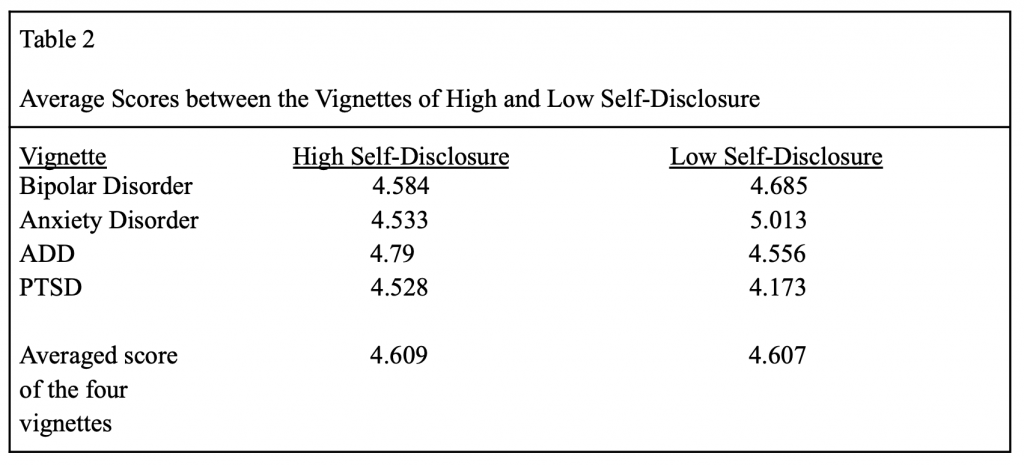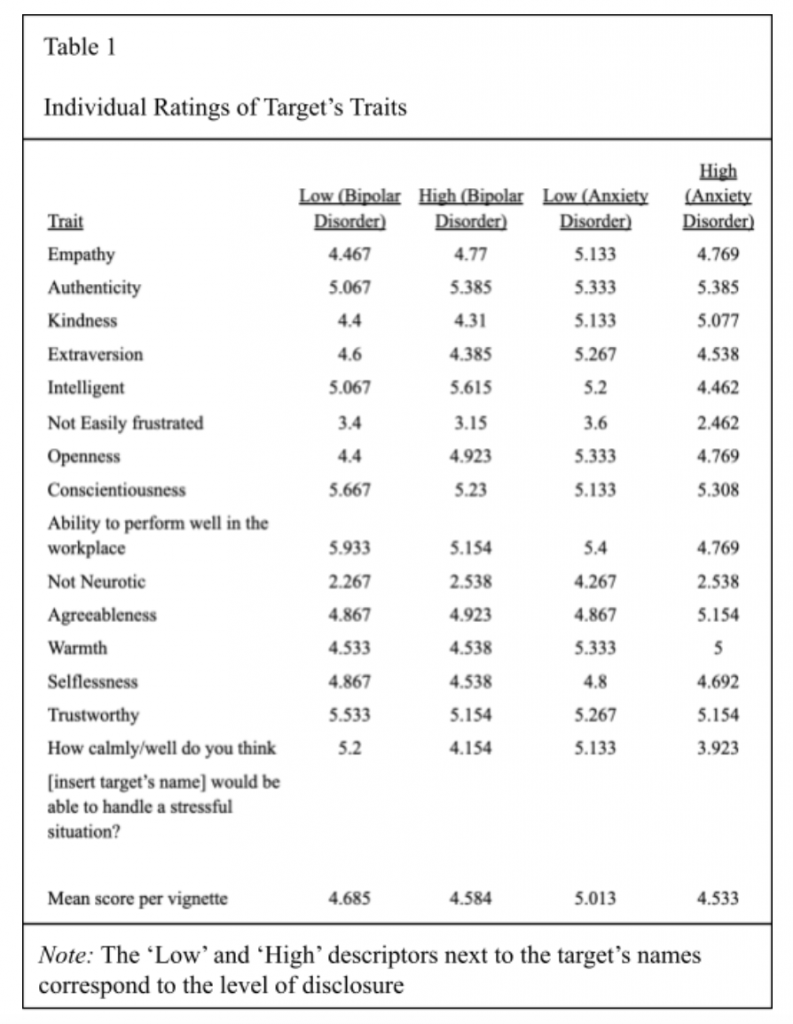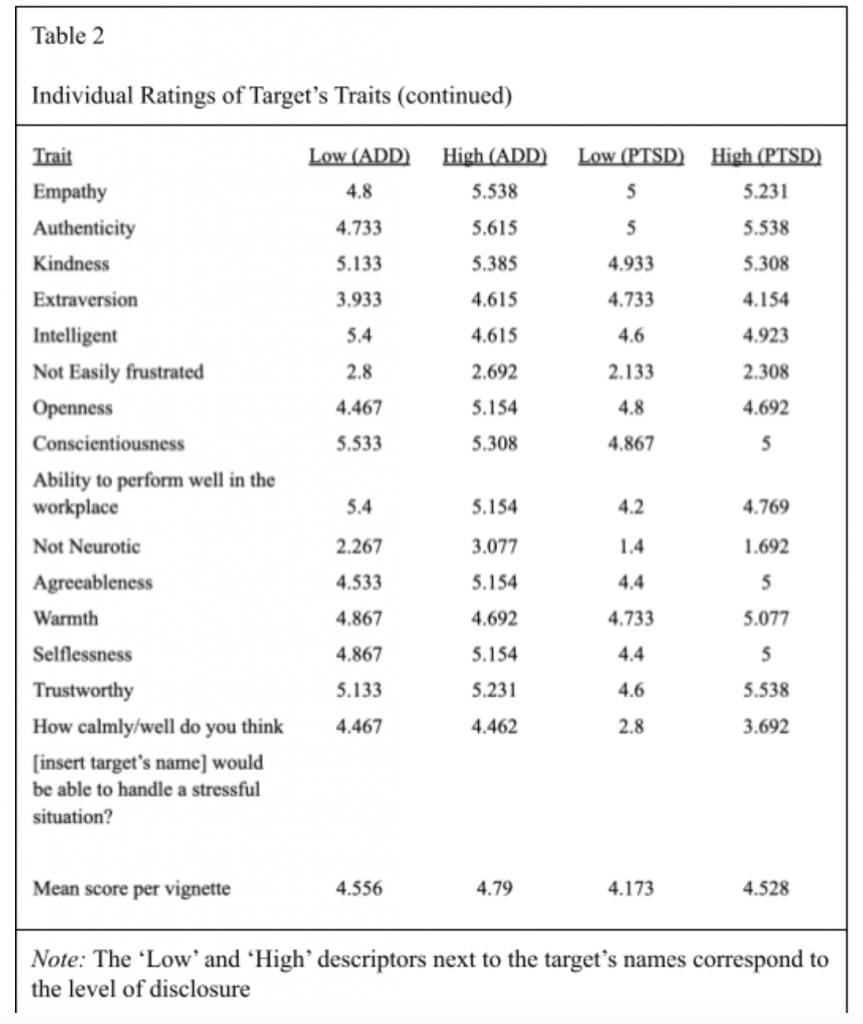
Author: Riya Daga
Mentor: Dr. Tara Well
Horace Mann
Abstract
This experiment explores how disclosing a mental disorder affects people’s perceptions of the target on a range of thirteen traits such as intelligence and agreeableness. It is hypothesized that disclosing a mental disorder can induce lower ratings on the targets’ abilities to perform well in the workplace, intelligence, and how calmly they could handle a given situation. When evaluating a total of twenty-eight responses across two Google Forms, no statistically conclusive evidence was found between those who disclosed a mental disorder and those who did not. Research participants read four vignettes narrated by the target (the actual vignettes can be found in Appendix A and B). Research participants were either assigned a condition where the target disclosed a mental order or a condition where the target did not disclose a mental disorder in the four vignettes. After reading each of the vignettes, research participants rated each of the targets on thirteen traits. Four major limitations could have affected the accuracy of the experiment and results: a small sample size; no preliminary testing on the content of the vignettes; using a convenient sample; no testing to see how the phrasing of the questions could have affected the research participants’ answers.
The Influence of Disclosing Mental Disorders on Impression Formation
Have you ever wondered if disclosing a mental disorder would be viewed negatively by a friend or employee? Consider this example: James is debating whether to disclose his anxiety disorder to his boss. On the one hand, he feels this information could help his boss understand his work style better, but on the other hand, he feels his boss may think he will have difficulty keeping up with the pace of the workplace. The following experiment was conducted to determine whether disclosing a mental disorder (such as ADD, Anxiety, Bipolar) in any environment negatively affects how people view the individual disclosing a mental disorder. Mental disorders, or mental illnesses, are occasional or chronic conditions that have an impact on one’s feelings, moods, behavior, and thinking (Mental Disorders, n.d.).
Television dramas, celebrities, and the younger generation are raising awareness around mental health and are helping lessen the stigma surrounding mental health (Spector, 2020). However, even though there is more awareness now about mental disorders, (such as attention deficit disorder (ADD), bipolar disorder, anxiety disorder, and post-traumatic stress disorder (PTSD)) individuals may still be unclear whether it would serve their best interest to self-disclose their mental disorders.
Self-disclosure is the process of revealing information to someone else intentionally or unintentionally. The information disclosed can vary in depth. For example, one example of self-disclosure may be revealing the name of one’s favorite color while another example may be sharing one’s biggest regret in life. An example of verbal self-disclosure could be sharing a phobia while an example of non-verbal self-disclosure could be a visible tattoo. Some benefits of self-disclosure include creating stronger bonds with the individual(s) one is self-disclosing, getting one to trust an individual more, greater life satisfaction, and better cooperation (Self-Disclosure, n.d.). The hypothesis for this study is that disclosing a mental disorder would lead to lower ratings in performance in the workplace, intelligence, and handling a situation calmly.
The decision to self-disclose a mental illness may vary based on the industry. In professions that rely more heavily on networking where traits such as Empathy, Authenticity, Kindness, extroversion, and Agreeableness were rated more highly in a high self-disclosure format, self-disclosing a mental disorder may be beneficial.
Past experiments conducted on the topic of impression formation and mental disorders online influenced many aspects of the experiment discussed in the rest of the paper. In one experiment, research participants viewed targets’ interviews and rated the targets on openness, conscientiousness, agreeableness, extroversion, neuroticism, physical attractiveness, and likeability (Fiedler et al., 2004). The target, or narrator, of the vignette, decides whether or not to disclose that they have a mental disorder. Some of the targets had personality disorders which are a type of mental disorders (Personality Disorders, n.d.). It was found that research participants rated those who displayed traits of paranoid, schizotypal, dependent, and avoidant PDs as less extroverted and less likable (Fiedler et al.). On the other hand, research participants rated targets who displayed histrionic PD (symptoms include a strong need for attention) as more extroverted and more likable (Fiedler et al (Fiedler et al.). Rating the targets on multiple personality traits inspired many of the questions in the experiment discussed in this paper.
Another experiment explored the impact on impression formation of disclosing a speech disorder or a mental disorder in the context of employment. In this experiment, research participants were presented with pictures and audio recordings of targets who were applying for a job at a university. Research participants were assigned a scenario with disclosure of either a speech or mental disorder. The scenarios contained no disclosure, visually implicit disclosure, or verbally explicit disclosure. Research participants were told to rate the targets’ characteristics after witnessing the scenarios. It was found that research participants viewed a speech disorder more favorably than a mental disorder in the context of employability (Fisher, 2007). Some factors people consider when deciding whether to disclose a mental disorder to their superior in the workplace are their gender, work setting, diagnosis, and emotional support in the workplace (Susman, 2021).
Inspired by past research that explored disclosing a mental disorder in the workplace, the following experiment further explored how disclosing a mental disorder affected people’s perceptions of the target without giving them the context of employment. After reading a vignette, research participants were asked to rate the targets on traits related to performance in the workplace. However, the purpose of rating the targets was not disclosed. As previously mentioned, before conducting this experiment, it was hypothesized that disclosing a mental disorder would lead to lower ratings in performance in the workplace, intelligence, and handling a situation calmly. The responses showed no significant results. By evaluating a total of twenty-eight responses across two Google Forms, no conclusive evidence was found between those who disclosed a mental disorder and those who did not.
In the context of how one would regard the individual disclosing a mental disorder after they disclose it: a negative perception would be quantified by lower ratings in categories such as performance in the workplace, agreeableness, openness, and various other traits. It can be beneficial to know whether or not people develop a more negative perception of an individual’s skills or traits when they disclose a mental disorder for a multitude of reasons. For example, the conclusions of the research could help an individual determine whether it would be beneficial to disclose their mental disorder to an employer, colleague, or friend.
Emotional self-disclosure, disclosing emotions and emotional experiences, can encourage empathy and trust while helping the individual disclosing a mental disorder cope with stress and burnout (Empathy at Work, 2022). Research found benefits of both: positive and negative self-disclosure. Surprisingly, negative self-disclosure is preferred and can have a positive influence (Zhang et al, n.d.). An example of negative self-disclosure could be “I am really bad at math” or “I struggle to manage my time well.” When disclosing negative information, the receiver may perceive the individual disclosing a mental disorder as honest and attribute other positive descriptions to the individual disclosing a mental disorder (Zhang et al, n.d.). An example of positive self-disclosure could be “I am really good at math.” When one discloses positive information, they may be perceived as dishonest since the information disclosed may seem to boast (Zhang et al, n.d.).
Self-disclosure can also be used as a tactic to make an individual seem more authentic. For example, someone in a position of power may self-disclose to employees- in both difficult and non-difficult situations- to show their ‘human side,’ which can compel employees to rally behind them (Zhang et al, n.d.). Similarly, in certain circumstances, it might be beneficial to disclose a detail that may seem ‘negative’ to create stronger bonds. To restate, it was hypothesized that disclosing a mental disorder would lead to lower ratings in performance in the workplace, intelligence, and handling a situation calmly. However, the responses do not confirm this hypothesis. Thus, it is important to understand some of the flaws in the experiment to gather more conclusive data.
Research Participants
Method
The forms used for the experiment were circulated via social media where followers viewed an Instagram story that explained the social experiment on impression formation. On the same slide, research participants were informed that their participation included filling out a form that would take 10-15 minutes to complete. The link given to research participants randomly assigned which of the two links they would complete. Social media seemed to be the best way to distribute the form given the time frame; on Instagram, the form would be shared instantly and the research participants would all have the same incentive: helping who they followed on social media.
Administration and Random Assignment
The link to access the Google Form was circulated online via Instagram. Research participants were randomly assigned one of two forms.
The Targets
Between the four targets in the vignettes, there was one young male (8), one young female (17), one older male (68), and one older female (42). The ages and genders of the targets were deliberately selected to gather insight into a diverse set of targets.
Experimental Stimuli and How They Were Comprised
The form had nine parts. The order of the questions in the individual parts was randomized. One section asked questions about the research participants’ demographics. After the demographics portion, a vignette was described and then the research participants were asked to provide their opinions of the target as an open-ended question. Then, the research participants were asked to score the targets on a scale of one to seven on thirteen personality traits/qualities. The thirteen traits were empathy, authenticity, kindness, extroversion, intelligence, easily frustrated, openness, ability to perform well in the workplace, conscientiousness, neuroticism (worrying frequently and easily slipping into anxiety and depression), agreeableness, selflessness, trustworthiness, and how calmly/well the target would be able to handle a stressful situation (Pappas & Biggs, 2021). The same format was repeated for the other three vignettes. Open-ended responses were featured to collect reasoning and thought into why research participants selected certain ratings.
Format of the Forms
Each form included four paragraph-long vignettes which disclosed the targets’ names, the targets’ ages, and a problem or accomplishment they encounter[ed] in the span of three days. The vignettes were written in the first person, with the target as the narrator. Across the four vignettes, the order of the information disclosed was the same. The only difference between the two forms was that in one form the target disclosed a mental disorder after they disclosed their age, and in the other form, the target did not disclose a mental disorder. The four mental disorders disclosed were bipolar disorder, anxiety disorder, ADD, and PTSD.
Results
Surprisingly, the two overall means between the high and low self-disclosure forms were not significantly different. By conducting statistical tests, it delineated that there was no statistical difference between the two overall means of the two forms. As shown in the table below, the only marginally statistically significant T-value was found in the vignette disclosing anxiety disorder: 1.811. If people did have different ratings it was not caused by the disclosure of a mental disorder. Thus, no conclusive evidence was found that disclosing a mental disorder affects people’s ratings of the thirteen traits listed above. Interestingly, when the target disclosed that he had PTSD, research participants rated him higher on the scale of calmly handling a stressful situation. In the three other vignettes, it was the opposite for this trait. The greatest difference between the means of vignettes was in the anxiety disorder vignette where the target disclosed he had anxiety. However, these differences were not statistically significant, but showed a slight trend in the data.
Discussion
Due to methodological errors in this preliminary experiment, no conclusive data was found. The results would be more indicative and conclusive with a larger sample size. Given the amount of content on the internet that describes the debate on whether or not to disclose a mental illness, this is an important issue that needs to be studied and there is still a need for conclusive data on this subject.
As an article from Psychology Today also notes, the stigma surrounding mental disorders can cause individuals to hesitate to disclose a mental disorder due to not wanting to be labeled negatively or a fear of rejection (Susman, 2021). One article written in 2013 disclosed that 70% of the global population with a mental disorder does not receive treatment (Thornicroft et al., 2013). Some factors which prevented individuals from receiving treatment for a mental disorder were a lack of knowledge about mental disorders, ignorance surrounding accessing treatment, and stigma attached to mental disorders (Thornicroft et al.). Similarly, data collected by the Substance Abuse and Mental Health Services Administration in 2020 found that 46.2% of adults in the U.S. with a mental disorder receive mental health services (Mental Illness, 2022). That means that over half the adults with a mental disorder in the U.S. did not receive treatment. There is both a lack of education and misinformation surrounding mental disorders which can cause misconceptions and lack of treatment (Shrivastava et al., 2012). Therefore, educating individuals on mental disorders can help eliminate stigma. Understanding people’s attitudes towards mental disorders can be beneficial to understanding specific causes of stigma which is why gathering data on this subject is crucial.
Limitations
This preliminary study had four major limitations. First, the research participants in this experiment were part of a convenient sample. Since all research participants were gathered through a message on social media, the motive- of the research participants who opted to complete the form circulated via Instagram- might have tampered with the accuracy of scores they assigned to targets. In contrast, using the data of randomly selected participants who are not incentivized to complete the form in order to assist someone they know personally might produce more authentic scores. Second, there was no preliminary testing to uncover any preconceptions related to the targets’ names, mental disorders, and targets’ problems described in the vignettes. This might have led to certain research participants answering the questions with a different perception which may have affected the results. Third, due to the time and resource constraints in which this experiment was designed and conducted, only a small number-twenty-eight participants, to be exact- of research participants filled out the survey. Thus, the confidence level in the certainty of data is less than ideal.
Tables




References
Empathy at work. (n.d.). Mind Tools. Retrieved August 17, 2022, from https://www.mindtools.com/pages/article/EmpathyatWork.htm
Fiedler, E. R., Turkheimer, E., Oltmanns, T. F., & Friedman, J. N. (2004). Perceptions of people with personality disorders based on thin slices of behavior. Journal of Research in Personality, 38(3), 216-229.
Fisher, R. (2007, April 14). To reveal or not to reveal: How disclosure of a speech or mental disorder affects impression formation and employability (L. Kunce, Ed.). Illinois Wesleyan University Digital Commons. Retrieved August 26, 2022, from https://digitalcommons.iwu.edu/cgi/viewcontent.cgi?article=2092&context=jwprc
Mental disorders. (n.d.). Medline Plus. Retrieved August 17, 2022, from https://medlineplus.gov/mentaldisorders.html
Mental illness. (2022, January). National Institute of Mental Health. Retrieved August 27, 2022, from https://www.nimh.nih.gov/health/statistics/mental-illness
Pappas, S., & Biggs, B. (2021, November 3). Personality traits & personality types: What personality type are you? Live Science. https://www.livescience.com/41313-personality-traits.html#section-neuroticism
Personality disorders. (n.d.). Mayo Clinic. Retrieved August 26, 2022, from https://www.mayoclinic.org/diseases-conditions/personality-disorders/symptoms-causes/s yc-20354463
Self-Disclosure. (n.d.). Mind Tools. Retrieved August 27, 2022, from https://www.mindtools.com/pages/article/self-disclosure.htm#:~:text=Research%20sugge sts%20that%20self%2Ddisclosure,boosting%20empathy%20and%20building%20trust.
Shrivastava, A., Johnston, M., & Bureau, Y. (2012, January). Stigma of mental illness-1: Clinical reflections. National Library of Medicine. Retrieved August 27, 2022, from https://www.ncbi.nlm.nih.gov/pmc/articles/PMC3353607/
Spector, N. (2020, January 10). Mental health: How we’ve improved and where we need to do better in 2020. NBC. Retrieved August 27, 2022, from https://www.nbcnews.com/better/lifestyle/mental-health-how-we-ve-improved-where-we -need-do-ncna1108721
Susman, D. (2021, January 14). Should you disclose your mental illness? Psychology Today. Retrieved August 26, 2022, from https://www.psychologytoday.com/us/blog/the-recovery-coach/202101/should-you-disclo se-your-mental-illness
Thornicroft, G., Henderson, C., & Evans-Lacko, S. (2013, May). Mental illness stigma, help seeking, and public health programs. National Library of Medicine. Retrieved August 27, 2022, from https://www.ncbi.nlm.nih.gov/pmc/articles/PMC3698814/
Zhang, L., Qin, Y., Cho, H., & Li, P. (n.d.). First impression formation based on valenced self-disclosure in social media profiles. https://www.ncbi.nlm.nih.gov/pmc/articles/PMC8249806/#B33
Appendix A
Vignettes Given to Research Participants in the First Form Where the Target Disclosed a Mental Disorder in the Same Sequence as the Form
My name is Anna. I am 17 years old and have bipolar disorder. Yesterday, I was jogging in my local park and when walking to my car, a biker crashed into me. Quickly, an ambulance came and I went to the hospital. I am a competitive pianist and have a competition in a week so I was nervous and needed to make sure I was okay and could recover quickly. I got an x-ray and luckily I just had bad bruising. Since I was in so much pain, I missed my classes today but emailed my teachers to make sure I would not miss any material. I now am going to try and finish my work. Tomorrow, I will meet with my teacher to discuss whether or not I should compete.
Figure 1: Anna’s Vignette (Bipolar Disorder)
My name is Max. I am 8 years old and have an anxiety disorder. I have a soccer game after school in 2 days and have been practicing a lot to prepare. I feel pretty good about my progress but am working on my free kicked as I missed one during the last game. After soccer practice today, I have to go home and get ready for my friend’s birthday party. I bought him a gift two days ago and hope that he likes it. I also have another birthday party after my soccer game in two days, but I feel that I might be too tired to go after the game. Well, I will see how it goes.
Figure 2: Max’s Vignette (Anxiety Disorder)
My name is Jane. I am 42 years old. I am a professeur and have ADD. I just finished grading my students’ tests and am now having a cup of coffee. I did not expect this week to be so hectic but luckily it was a good type of hectic. Two days ago, I received an email from the school board with the news that I earned a promotion. I hesitated to open the letter as letters from the school board do not often come with good news, but was happy to feel that my work was being acknowledged. Then, yesterday, I attended my sister’s wedding. It was nice to be able to spend time with my family after a while.
Figure 3: Jane’s Vignette (Attention Deficit Disorder)
My name is Ted. I am 68 years old. I am a real estate agent and have PTSD. The last 3 days have given me new insights. 2 days ago I was at a work conference in the morning and then flew to an awards ceremony for my colleague in the afternoon. Yesterday, I flew to Hawaii with my family for a much-needed family vacation. On the way to the airport, I saw a car crash which made me feel very nervous. In fact, I almost stopped in the middle of the road. Luckily, I was able to calm myself down and continue driving.
Figure 4: Ted’s Vignette (Post Traumatic Stress Disorder)
Appendix B
Vignettes Given to Research Participants in the First Form Where the Target Did Not Disclose a Mental Disorder in the Same Sequence as the Form
My name is Anna. I am 17 years old. Yesterday, I was jogging in my local park and when walking to my car, a biker crashed into me. Quickly, an ambulance came and I went to the hospital. I am a competitive pianist and have a competition in a week so I was nervous and needed to make sure I was okay and could recover quickly. I got an x-ray and luckily I just had bad bruising. Since I was in so much pain, I missed my classes today but emailed my teachers to make sure I would not miss any material. I now am going to try and finish my work. Tomorrow, I will meet with my teacher to discuss whether or not I should compete.
Figure 1: Anna’s Vignette (Bipolar Disorder)
My name is Max. I am 8 years old. I have a soccer game after school in 2 days and have been practicing a lot to prepare. I feel pretty good about my progress but am working on my free kicked as I missed one during the last game. After soccer practice today, I have to go home and get ready for my friends birthday party. I bought him a gift two days ago and hope that he likes it. I also have another birthday party after my soccer game in two days, but I feel that I might be too tired to go after the game. Well, I will see how it goes.
Figure 2: Max’s Vignette (Anxiety Disorder)
My name is Jane. I am 42 years old. I am a professeur. I just finished grading my students’ tests and am now having a cup of coffee. I did not expect this week to be so hectic but luckily it was a good type of hectic. Two days ago, I received an email from the school board with the news that I earned a promotion. I hesitated to open the letter as letters from the school board do not often come with good news, but was happy to feel that my work was being acknowledged. Then, yesterday, I attended my sister’s wedding. It was nice to be able to spend time with my family after a while.
Figure 3: Jane’s Vignette (Attention Deficit Disorder)
My name is Ted. I am 68 years old. I am a real estate agent. The last 3 days have given me new insights. 2 days ago I was at a work conference in the morning and then flew to an awards ceremony for my colleague in the afternoon. Yesterday, I flew to Hawaii with my family for a much-needed family vacation. On the way to the airport, I saw a car crash which made me feel very nervous. In fact, I almost stopped in the middle of the road. Luckily, I was able to calm myself down and continue driving.
Figure 4: Ted’s Vignette (Post Traumatic Stress Disorder)
About the author
Riya Daga
Riya is a senior at Horace Mann. She is a semi-pro racecar driver who is also passionate about skincare, the business of Formula 1, entrepreneurship, and ultimate frisbee. She lives in Englewood Cliffs, NJ and loves playing Connect Four and cards.
